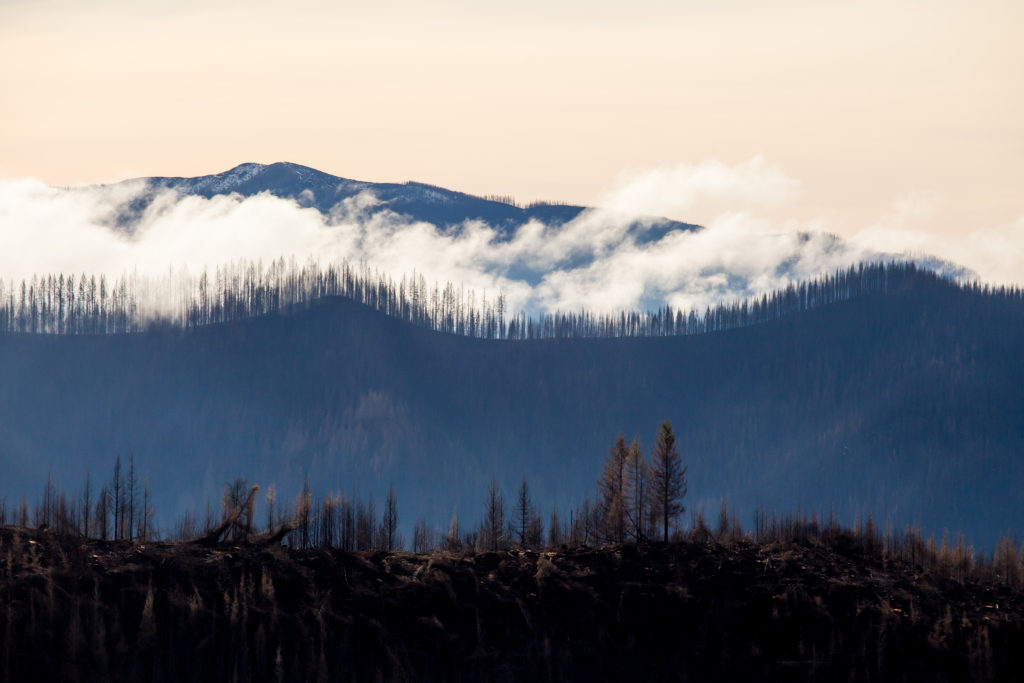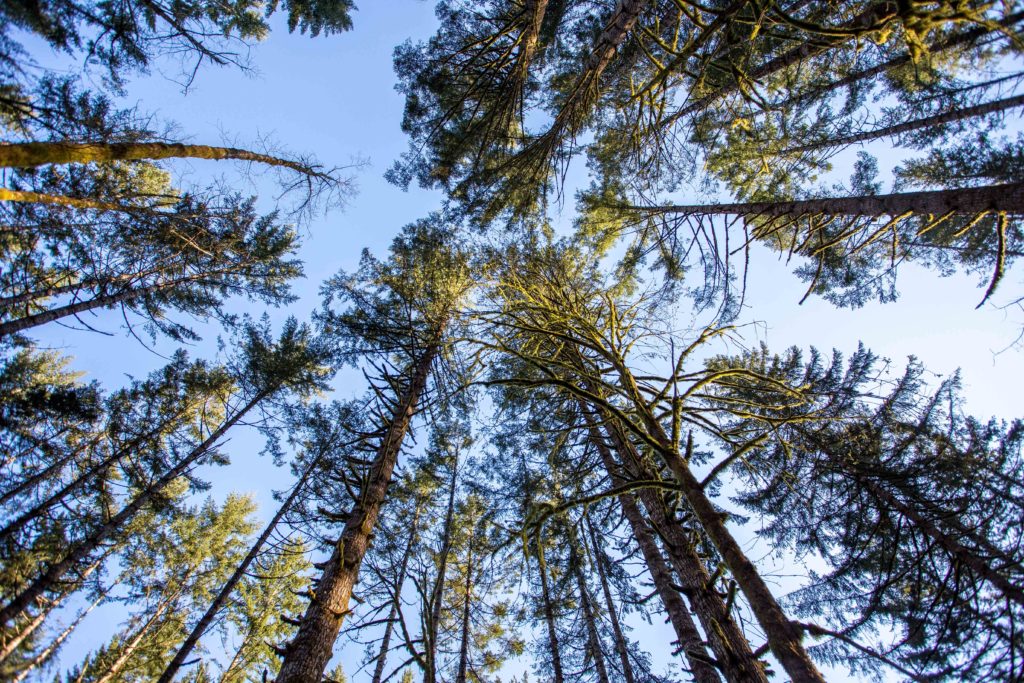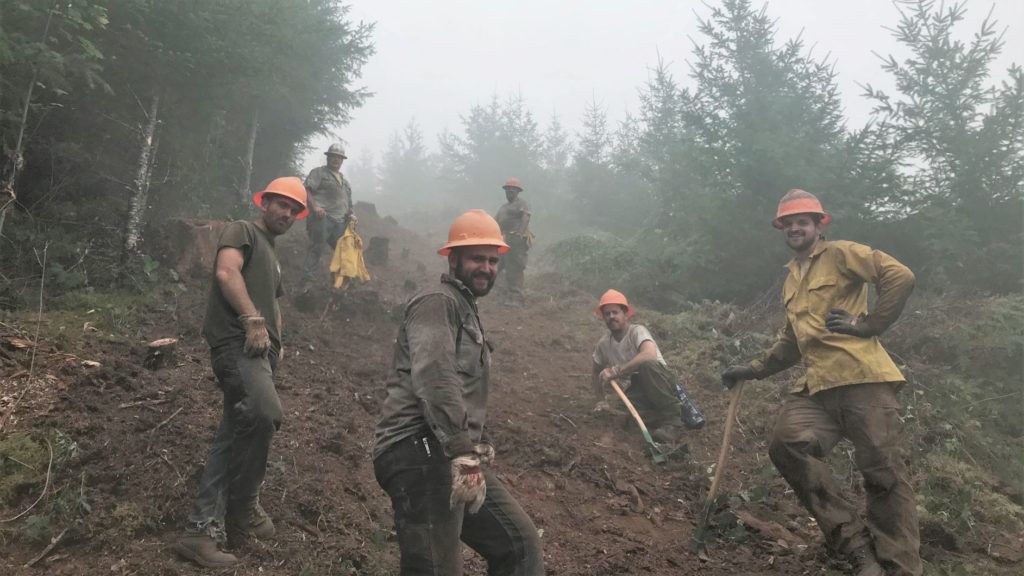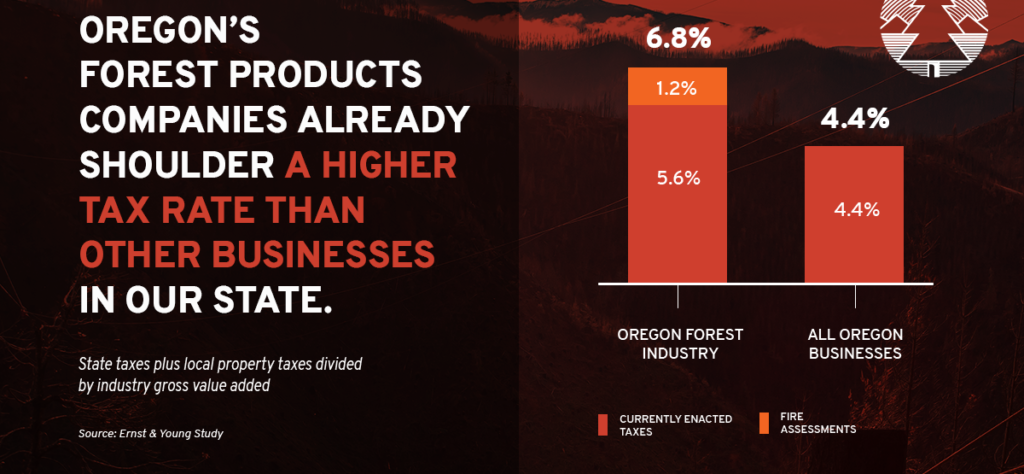In an effort to help policymakers better understand Oregon’s wildfire funding system, today OFIC launched a new explanatory section of its website dedicated to wildfire funding and the current funding crisis. Check it out here!
OFIC Launches New Public-Facing Campaign
On June 6, 2022 OFIC launched the start of a long-term initiative called For the Trees that showcases Oregon’s timber industry as part of the solution to the social, economic and environmental issues Oregonians care about most. The forest products sector in Oregon is undeniably part of the solution to climate change, catastrophic wildfire prevention, affordable housing, and a healthy environment, and economic opportunity for families throughout Oregon – and this campaign illustrates that.
Oregon is changing and population growth has left many Oregonians with a lack of awareness about the timber industry. For the Trees re-introduces Oregonians to one of Oregon’s flagship industries and celebrates the timber industry’s important story about being part of Oregon’s past and future.
Recently, the timber industry and environmental groups reached a historic agreement that resulted in the most comprehensive changes to Oregon’s forestry regulations in fifty years, which demonstrates how opposing sides can work together on viable solutions to some of the toughest problems facing Oregonians today. It is this spirit of collaboration that the For the Trees campaign celebrates.
Private Forest Accord Update
In the February 2022 legislative session, Oregon legislators will be asked to codify in state law a comprehensive set of changes to the Oregon Forest Practices Act. The set of changes resulted from more than a year of scientific review and negotiations between private forestry representatives, small forestland owners, and environmental groups, known as the Private Forest Accord.
For current information on the Private Forest Accord, please click here.
Deal would overhaul private forest management in Oregon
October 30, 2021
**This story originally published via the Associated Press
SALEM, Ore. (AP) — An agreement has been reached between timber and environmental groups to overhaul management of 10 million acres of private forestlands in Oregon.
Oregon Public Broadcasting reports the deal, announced Saturday by Gov. Kate Brown’s office, concludes more than a year of negotiations to develop a plan to boost protections for vulnerable fish and wildlife while shielding the timber industry’s ability to log.
Friday was the deadline for both sides to either reach consensus, abandon the process or move the deadline.
“Today’s historic agreement is a perfect example of the Oregon Way –– coming together at the table to find common ground, to the mutual benefit of us all,” Brown said in a statement. Jim James with the Oregon Small Woodlands Association similarly praised the compromise.
“We were able to put down the contentious situations that we’ve had in the past and we had a continuous agreement to move forward,” James said.
Speaking on behalf of the timber coalition, Adrian Miller with the Florida-based forest products company Rayonier said Saturday’s agreement gives timber operators a sense of security going forward.
“I think we’re all really proud to be part of a new era of forestry in Oregon,” Miller said.
In 2020, the sides each planned a series of competing ballot measures that could have turned into a costly political fight.
Environmental groups sought strict limits on spraying of aerial pesticides and improved protection for forest waters. Meanwhile, the timber industry sought compensation for private landowners when state regulations limited their ability to log.
Brown instead pushed for the two sides to negotiate.
Representatives from the timber industry and environmental groups were charged with setting terms to pursue a statewide habitat conservation plan to safeguard fish, wildlife and water quality. A habitat conservation plan, or HCP, is a tool that allows practices like logging or irrigation to continue while minimizing damage to wildlife habitat.
Saturday’s deal sets in motion what could be a lengthy, possibly yearslong process to craft, approve and adopt an HCP into law and begin implementation.
“There’s no doubt that there’s gonna be challenges ahead,” said Sean Stevens, executive director of the conservation group Oregon Wild. “But I do think that this agreement provides a different sort of foundation than we’ve ever had before for tackling those challenges ahead.”
The next step will be to introduce a bill in the Oregon Legislature to make significant changes to the Forest Practices Act to protect riverbanks and streamsides, improve forest roads and allow for adaptive management of private forests.
Then the state will pursue an HCP, which will require a rulemaking process overseen by the Oregon Board of Forestry. After that, state leaders can pitch the plan to federal regulators.
Q&A with Roseburg: Post-fire Restoration
**This post originally appeared on Oregon Forests Forever
It’s been almost a year since the 2020 Labor Day fires torched over a million acres in Oregon, and now we’re in the midst of another summer and another potentially destructive fire season. Even before June 2021 was over, we saw three times more fires start and three times more acres burned in Oregon than is normal for that time of year.
Every corner of Oregon is suffering drought. Any rain we’ve seen has been spotty, and really only helpful west of the Cascades.
As we’re deep into another fire season, we thought we’d check in with Charley Moyer, District Forester, and Jason Colter, Senior Forester at Roseburg Forest Products to find out what they’ve been doing in areas of private forests that were burned to make sure they don’t re-burn this fire season.

1. How many acres of Roseburg forestlands burned or were affected by large fires?
Roseburg is no stranger to fires: since 2013, we’ve had well over 48,000 acres of our timberlands severely impacted by five large fires.
2. What does Roseburg do after a large fire?
Our planning for rehabilitation starts as soon as we start to grasp the fire impacts – often, while still fighting the fire! Hazards, such as fallen trees, must be mitigated and all infrastructure evaluated for safety. Roads have to be cleared and culverts must often need to be replaced to ensure access.

We then salvage the burned merchantable timber on our property and replant both salvaged areas as well as burned areas that could not be salvaged. Harvest of these standing dead trees and reforestation is vital for quick stabilization of soil, protection of clean water, and restoration of vital habitat for fish and wildlife for decades to come.
Reforestation also re-starts the clock on carbon sequestration; leaving standing dead timber is not a climate solution, as the burned, dead wood emits CO2 when it breaks down or quickly releases vast quantities of carbon in a subsequent fire.
3. What about this summer – is there a chance those acres could burn again? What are you doing to prevent that?
Yes, burn scars are extremely susceptible to burning again. The Tillamook Burn is a great example of this here in Oregon – it re-burned four times over an 18-year period! The Archie Creek Fire (2020), for example, re-burned over the North Umpqua/Fall Creek Fires (2017), the Cable Crossing Fire (2015), the Williams Creek Fire (2009), and the Apple Fire (2002). Currently, the Jack Fire (2021) is burning in the fire scars of the Happy Dog Fire (2017), Limpy Fire (2002), Apple Fire (2002), Calf 2 Fire (2002), Spring Fire (1996), Apple Fire (1987), and Jack Point Fire (1987). [Source]
Removal of the standing dead trees takes fuels out of the equation, should a fire start in the area again. Snags can also pose hazards to forest workers or firefighters. Re-establishing a young, vibrant forest is most effective in preventing a re-burn.
The Oxbow Fire of 1966 is a great example of perhaps the only large fire in the last 100+ years that has not re-burned. Most of Roseburg’s lands in western Oregon are “checkerboarded” with public lands, and after the 42,000+ acre Oxbow Fire had been stopped, both sides of the property lines, federal and private alike, were promptly salvaged and reforested. These management activities reduced the remaining fuels and quickly re-established forests, which has resulted in no major re-burn of this area since that fire in 1966. While salvage removes future hazards like snags, reforestation that fully restocks the forests with native species provides long-term shading (much quicker than natural regeneration after fires) which increases moisture retention and helps reduce highly flammable brush. All fires within the original burn area have been extinguished at a small size and without the worry of fuel loading or hazards from standing dead timber.
Based on notes recorded by previous foresters of this era, the aggressive salvage of both the private and public lands on the Oxbow Fire was a decision based on the history of the Tillamook Fires; it was an intentional long-term fuel reduction project. [Bob Zybach is a great source for West Oregon fire history.]
4. Are burned forests still open to recreation?
While rehabilitating our lands, we close burned areas to public access for safety reasons. Recreating in burned areas is not a good idea – dead trees can fall at any time, hitting someone or blocking a road; un-stabilized soil can give way; and infrastructure that looks safe on the surface could have significant structural defects.
When rehabilitation is complete, we will communicate the change in recreation status via signs at main entry points such as gates, our website, and our social media channels; we close all of our lands to public access seasonally when the Industrial Fire Precaution Level (IFPL) reaches Level II. Recreation access information for our lands can be found here.
5. How do post-fire restoration efforts differ from standard forest practices? Do you still have to follow the same laws?
The Oregon Forest Practices Act allows for emergencies and recovery from disasters such as wildfire, storm damage, and insect outbreaks; ODF reviews planned operations to ensure compliance. The size of salvage harvest areas may be larger than typical to reflect the disaster’s impact and severity, as well as the need to salvage the dead trees in a timely manner to avoid wood degradation.
Reforestation of burned areas is only required by law if salvage harvests are conducted. Roseburg chooses to reforest non-salvaged lands for a variety of reasons such as long-term sustainability, resource protection, and our long-term vision for our land management goals.
6. What does a forest that’s had post-fire treatment look like 5 or even 10 years later compared to one that hasn’t had treatment?
In 2014, the Yellow Point Fire, an arson, was sparked within the footprint of the Oxbow Fire (1966) on our lands.
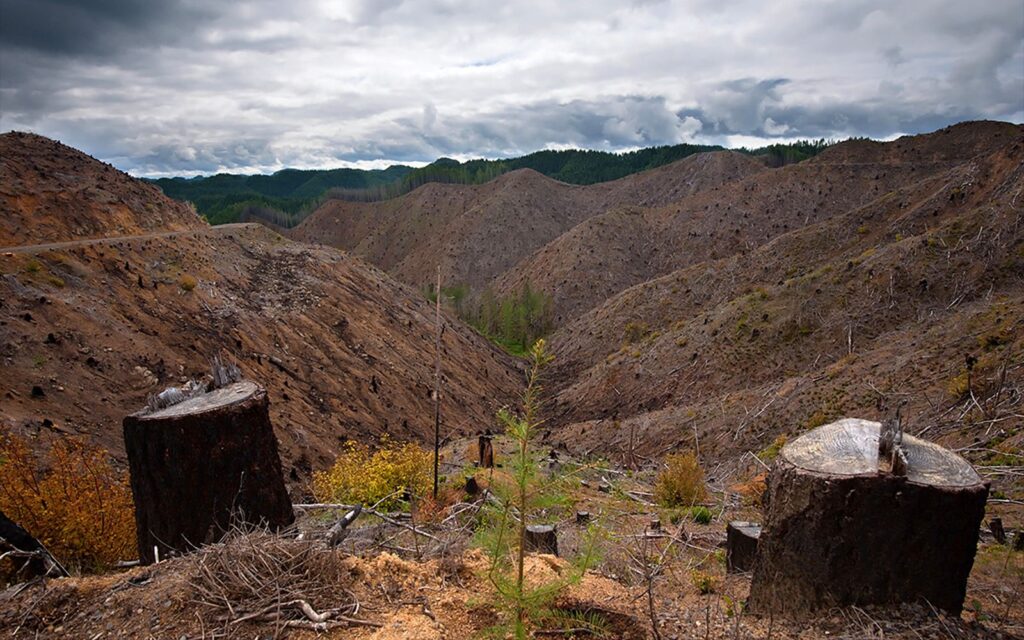
Due to the management practices after the Oxbow Fire, we were easily able to stop this fire at just 790 acres. We again managed our lands like before – salvage harvesting and reforesting as soon as possible. Reforestation establishes a healthy, vibrant forest quickly after disasters like this. Here is what it looks like today (2021)!
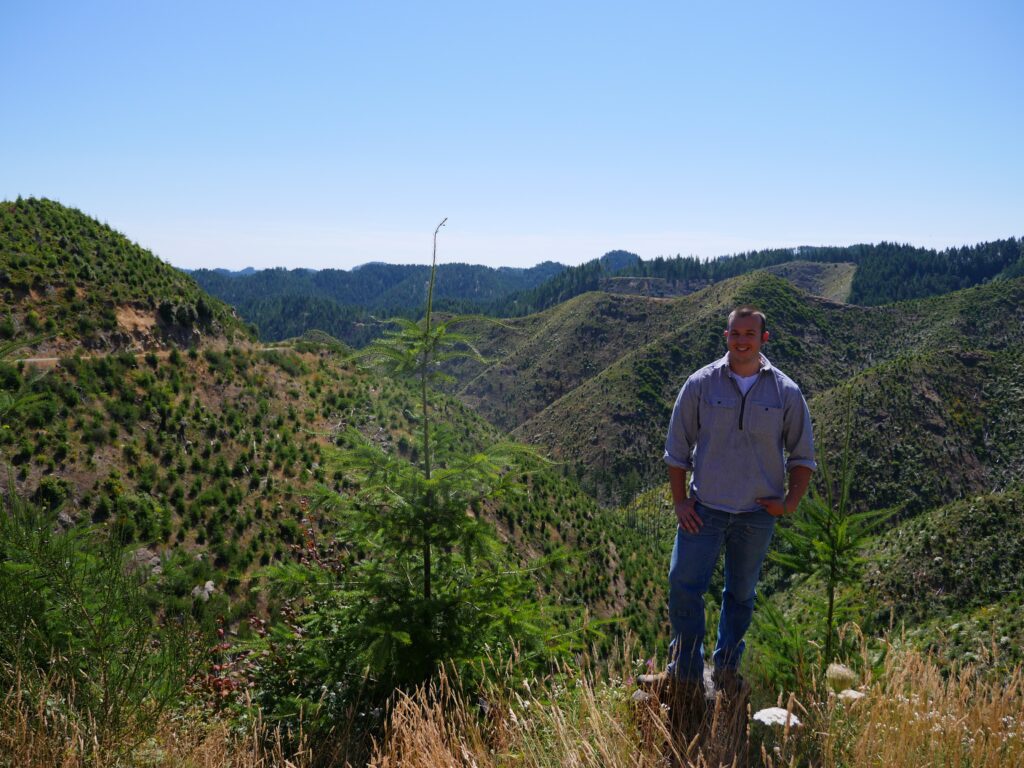
7. There’s a lot of misinformation out there about “salvage harvests.” What is a salvage harvest and how is that different than harvest of a healthy forest?
Salvage harvest is the removal of dead, dying, or deteriorating trees after an event such as wildfire or snow/ice/wind damage. These operations must occur before the wood deteriorates, and differ from “regular” harvests in that we typically do not plan to harvest these areas, and often at such a large scale. Sometimes these salvage operations harvest trees that are “green” and appear to still be alive; however, the damage to their foliage and roots means that they will die sooner than later. Also, some trees that do survive fires often don’t do well after their ‘neighbors’ die off or are salvaged, due to wind and sun exposure they’ve not been used to.
These salvage harvests are a long-term fuel reduction and insect management tool. While the fire is part of the natural ecosystem, the fire return interval is measured in hundreds of years in western Oregon, versus 10’s of years in eastern Oregon. The big game-changer is the amount of public-caused fires and climate change. Having more starts per year and generally drier conditions increases the potential for large fires.
8. Can the burned trees be used for lumber? What happens with them?
Yes! The fire killed the large trees, but as you can see in the pictures, the damage is mostly contained to the bark. This means that inside the bark, the wood is still solid and good for use.

But we do need to harvest the dead trees as quickly as possible – wood-boring beetles are attracted to the dead trees and can wreak havoc on wood quality. Also, once winter rains hit the year following the fire stain can set in and rot begins to occur.
Our burned logs get sent to our mills and utilized just like unburned logs.
Oregonians Shocked by ODFW Commission’s Denial of Science in Marbled Murrelet Decision
[SALEM, August 24] – Oregon’s Department of Fish and Wildlife Commission voted in favor of elevating the marbled murrelet, a small seabird, from threated to endangered on the Oregon Endangered Species list despite nearly 900 Oregonians who urged commissioners to reject the move. Commissioners also ignored advice from their own Fish and Wildlife staff, who advised against the uplisting, and data from federal agencies showing growth in the marbled murrelet population and habitat over the past two decades.
The decision is not sitting well with Oregonians across the state. Oregon Forests Forever, a statewide coalition of individuals, organizations and businesses who support active, sustainable management of Oregon’s forests, solicited reactions and responses to the decision. Many of them said they feared the listing would devastate local economies and communities and considered the decision in direct conflict with scientific data.
“If a species is to be listed as endangered, then there ought to be science to point to the need for such a designation,” said Woodburn resident Sherman Lackey. “If the science is ignored, the commission has abandoned their responsibly and violated the law. The commission needs to revisit their decision regarding the marbled murrelet and follow the science.”
“As a native-born Oregonian, I am against this policy on the marbled murrelet,” said Stayton resident Richard Ackerman. “The course of the commission is dead wrong when the science says they are thriving. Listing them will only cause irreparable harm to our forests and communities.”
None of the scientific data support an uplist decision for the small sea bird. The U.S. Fish and Wildlife Service reports within a 95% confidence interval that the population is rising by approximately 2.2% per year. Additionally, the U.S. Forest Service and U.S. Fish and Wildlife Service have concluded all types and forms of murrelet habitat have been increasing since the listing of the species in the 1990s. ODFW biologists concluded the same in their analysis, stating “the amount of murrelet nesting habitat will likely continue to increase over time in Oregon.”
In response to the commission’s decision, Parkdale resident Jeffrey Snyder said, “This appears to be another political decision that is not based on science, but politics.”
Several responders to Oregon Forests Forever cited the listing of the northern spotted owl and the economic fall-out as reasons the commission should consider the impact a decision like this has on communities.
Florence resident said Lori Wangerin said, “The spotted owl cost my husband his job that he loved with the Forest Service. Don’t allow this to cost the jobs of other families.”
Wilsonville resident Karen Frey said, “Please don’t put more regulations on the timber industry again. The spotted owl decimated so many towns, communities and lives. Don’t do it again. The marbled murrelet should not be classified as endangered.”
In an all-day zoom meeting on July 9, the ODFW Commission received opposition testimony from several organizations, certified wildlife biologists and current and past elected officials who represent or represented constituencies who would be impacted by the decision, including Coos County Commissioner Johns Sweet, 1st district Oregon House Representative David Brock Smith (who represents all of Curry County and parts of Coos, Douglas, and Josephine counties) and former Tillamook County Commissioner and current ODFW Commissioner Mark Labhart.
The commission also received legal testimony from Kirk Maag, environmental and natural resources attorney at Stoel Rives LLP, who concluded “reclassification of the marbled murrelet as endangered would violate applicable laws” as none of the statutory requirements to reclassify the species have been met.
“It’s unconscionable that the commission has made a decision that flies in the face of reality and is an absolute slap in the face to decades of costly investments by rural Oregonians,” said Seth Barnes, Director of Forest Policy for the Oregon Forest and Industries Council. “The growing marbled murrelet population and habitat is a result of forest policy decisions that cost many Oregonians their livelihoods. Those Oregonians know, intimately, the short and long-term consequences of these decisions: first job loss and poverty followed by increasing fuel loads that lead to catastrophic wildfires, poor air quality, public health, and lost resources.”
Tillamook resident Ellie Hilger echoed Barnes’ concerns, stating she was shocked and very disappointed to hear of the commission’s decision. “Overlooking sound science will be devastating to my local economy. I am a teacher, and my husband is a forester on the Tillamook coast. Our community relies on timber as part of our economy. Why take that away from us? My husband and I have a little girl, and God willing, we wish to have more children. We can’t stay here if my husband doesn’t have a job to support our family.”
The seven-member commission is appointed by the Oregon Governor and confirmed by the Oregon Senate.
“Clearly the commission’s decision completely disregarded the professional recommendations of its own agency biologists. This sends a strong message that there’s a disconnect between what the science would seem to say and the politics of this issue,” said Kyle Williams, Director of Forest Protection for Oregon Forest and Industries Council. “Avoiding agenda driven management of Oregon’s fish and wildlife is critical, and this decision is another example of how important it is to have balanced representation from across the state. We strongly urge the Governor to consider this as she fills the long expired Congressional District 3 seat.”
Photo Credit: Thomas Hamer, Hamer Environmental L.P.
###
The Oregon Forest & Industries Council is a trade association representing more than 50 Oregon forestland owners and forest products manufacturers. OFIC’s members combine sustainable forest management practices with the latest science and technology to continuously improve the environmental, social and economic value of healthy working forests. We protect and manage more than 5 million acres of Oregon forestlands, employ nearly 60,000 Oregonians, and make Oregon the nation’s largest state producer of softwood lumber and plywood. For more information, go to ofic.com.
Contact: Sara Duncan
Phone: 503-828-2373
Email: sara@ofic.com
Oregon Forest & Industries Council Hires New President

Today the Oregon Forest & Industries Council board of directors announced it has selected Chris Edwards as the organization’s next President. Currently President of government relations firm Tivaci Group LLC, Edwards will transition into his new role in the first week of July.
“We are extremely fortunate to have secured Chris to lead OFIC’s high-functioning team of professionals,” said Todd Payne, OFIC Chairman of the Board and President and CEO of Seneca Jones Timber Co. “We are confident his track record of finding common ground through a solutions-oriented, forward-looking approach will continue the industry’s momentum into the next generation. Chris is truly one of us. With roots in the woods and sawdust in his veins, he comes from a family-owned and operated mill business and has always been a champion of natural resources issues both in and out of the Legislature. We are looking forward to the positive energy he will bring to our team.”
Edwards comes to OFIC with ten years of extensive leadership experience in the Legislature, having served as a Democrat for three years in the Oregon House representing House District 14 (West Eugene and Junction City) followed by seven years in the Oregon Senate representing District 7 (North Eugene, West Eugene and Junction City). While in the Legislature, Edwards was known for his ability to work seamlessly with both political parties on intensely controversial environmental issues in pivotal committee positions, including Chair of the Senate Environment and Natural Resources Committee, and Co-Chair of the Natural Resources Joint Sub-Committee of Ways and Means.
In 2016 Edwards stepped down to accept the position of Assistant Vice President for Strategic Initiatives at the University of Oregon. Edwards left the University after two years to start his own government relations firm, where OFIC has been his largest client since 2019. A native of Eugene, Edwards spent several years working at his family owned and operated mill in Goshen and running a small forest products export/import company before his tenure in the Legislature.
“I am truly honored to take on this new role and add strength to the collaborative focus of today’s forest products sector,” said Edwards. “This is an exciting time to be involved in forest policy and working with some of the most pioneering forestry professionals in the world. Private forests provide environmental, social and economic benefits for all Oregonians – from clean water to carbon capture and storage in long-lived wood products to wildlife habitat to tens of thousands of family-wage jobs – our industry is inherently part of the solution to climate change and an economic main stay of Oregon. I look forward to working with OFIC members and other partners as we advance into the future of Oregon forestry.”
Edwards will replace Kristina McNitt, who is retiring after nine years as OFIC President, and 25 years of natural resource advocacy before the Oregon state legislature.
“Kristina capably led and empowered OFIC staff for nine years through critically important moments of our industry’s history,” said Payne. “Her loyalty, instinct, strategic thinking, work ethic and grit will be sorely missed, but we are overjoyed for her to finally get to relax in retirement – she has more than earned it.”
Herd Freed Hartz, based in Seattle, conducted the executive search on behalf of the OFIC board of directors.
###
The Oregon Forest & Industries Council is a trade association representing more than 50 Oregon forestland owners and forest products manufacturers. OFIC’s members combine sustainable forest management practices with the latest science and technology to continuously improve the environmental, social and economic value of healthy working forests. We protect and manage more than 5 million acres of Oregon forestlands, employ nearly 60,000 Oregonians, and make Oregon the nation’s largest state producer of softwood lumber and plywood. For more information, go to ofic.com.
Contact: Sara Duncan
Phone: 503-828-2373
Email: sara@ofic.com
Oregon Forest Protective Association Receives Forestry Appreciation Award from Oregon Society of American Foresters
For Immediate Release
Contact: Andrea Watts, OSAF: 503-224-8046, wattsa@forestry.org
PORTLAND—The Oregon Forest Protective Association (OFPA) has received the Forestry Appreciation Award from the Oregon Society of American Foresters (OSAF). Members of the OFPA accepted the award at the OSAF virtual Annual Meeting on May 13, 2021. This award is presented whenever appropriate to individuals, groups or institutions outside the forestry profession that have contributed significantly to the advancement of forestry in Oregon.
Oregon Forest Protective Association (OFPA) was incorporated in 1910 as the OFFA (Oregon Forest Fire Association), which was changed to Oregon Forest Protective Association in 1958. This system has become known as Oregon’s Complete and Coordinated Fire Protection System, which includes forest protective associations statewide, the Oregon Department of Forestry (ODF), and cooperating agencies. The forest protective associations are made up of forest landowners, both industrial and non-industrial, as well as Bureau of Land Management (BLM) in western Oregon. Three of the associations are operating associations, providing protection for their members and other forest landowners by contract with the State Forester.
“Oregon’s wildland firefighting system is unique in its public/private partnership,” said Kyle Williams, Director of Forest Protection for Oregon Forest & Industries Council. “Forest landowners and forest industry operators and contractors engage on a regular basis with Government firefighting personnel (primarily ODF) to provide enhanced initial attack capability with their own company firefighting equipment and personnel. Loggers, road builders, timber fallers and reforestation contractor crews routinely leave their ‘day jobs’ to do initial attack on fires in successful efforts that extinguish fires early, keep resource loss to a minimum and provide special skills and equipment to build fire line, open roads, fall burning snags, extinguish hot spots and provide mop-up services.”
During the 2020 fire season, the entirety of western Oregon, from the Oregon-California border north to nearly the Columbia River, was enveloped by fire. Five fires in the Cascades burned over 100,000 acres each, moving into Oregon’s top 20 wildfires by size since 1900. All told, over a million acres burned in total in Oregon including losses on U.S. Forest Service-protected (USFS) lands. Roughly 400,000+ acres burned on the private, state, and local government lands fully protected by ODF or fire protective associations, with another 100,000+ acres burned on western BLM lands for which ODF and the associations have initial attack responsibility.
“When the Labor Day fires blew up and quickly exhausted all government agency resources, that private partnership became critical to the efforts to protect homes and communities,” explained Williams. “Private timber industry employees and landowners immediately engaged on the hundreds of miles of fire line throughout the state—those woods workers who would normally be managing an operation, laying out a unit, running a log-loading shovel, building road with an excavator, setting chokers or thinning young forest stands—hauled over 350 pieces of equipment and deployed over 650 trained personnel to the fires and pitched in side by side with ODF and USFS fire fighters in what became an incredible example of the complete and coordinated system.”
Oregon’s complete and coordinated system, although sorely tried and tested, delivered in the end.
OSAF and its 15 local chapters represent all segments the forestry profession within the state. The society includes public and private practitioners, researchers, administrators, educators, and forestry students. Its mission is to advance the science, education, technology, and practice of forestry; to enhance the competency of its members; to establish professional excellence; and to use the knowledge, skills, and conservation ethics of the profession to ensure the continued health and use of forest ecosystems and the present and future availability of forest resources to benefit society.
###
Oregon Timber Tax Q&A with Todd Payne
**This post originally appeared on Oregon Forests Forever
The Oregon Legislature is currently considering increasing taxes paid by the timber industry, prompting many questions about the taxes the industry already pays. Todd Payne, President and CEO of Seneca Jones Timber Co., takes on the most commonly asked questions and sets the record straight. Seneca is one of Oregon’s oldest family-run forest products companies. Payne also serves as chairman of the Board of the Oregon Forest and Industries Council.
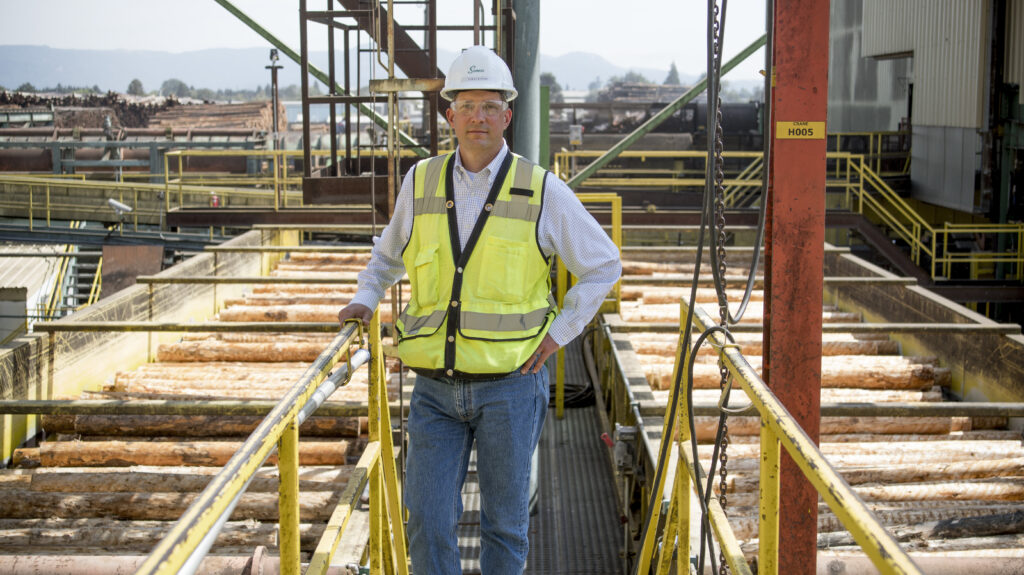
Q: Tell us about the new tax study that just came out from Ernst & Young – what were the primary findings?
A: On April 13 the Oregon Forest & Industries Council released a groundbreaking report from national accounting firm Ernst & Young detailing the total tax burden on the private forest sector in Oregon. The report’s primary finding concludes the Oregon forest sector pays more than one-and-a-half times more on average than other Oregon businesses. The report calculated the total tax burden by aggregating all taxes paid by the sector, including property taxes, income taxes, small tract forestland taxes, corporate income and excise taxes, fire assessments and privilege taxes. All told, in 2019 the forest sector contributed over $142 million to state tax coffers. This report unequivocally concludes our sector already pays more than its fair share in taxes and it vindicated our sense that additional tax increases under consideration are motivated more by philosophical differences about forest management than they are by any sense of tax equity.
Q: What does this tell you about legislation under consideration by the Legislature?
Given the report’s findings, we now know that legislation under consideration in the 2021 legislative session would effectively double the total taxes currently paid by the forest sector. That would increase the forest sector’s effective aggregate tax rate to nearly three times more than other Oregon businesses pay. At a time when the latest state revenue forecast indicates the Legislature has nearly $800 million more to work with this session than it originally thought and has billions of dollars in reserves, doubling the tax burden on the forest sector seems unnecessary.
Q: I read lumber prices are at record highs right now and multi-national corporations are making record profits. Why isn’t this an appropriate time to raise taxes on the industry?
A: Suggesting Oregon’s private forestland owners who just lost more than 400,000 acres to wildfire should be taxed because mills are realizing profits during a pandemic DIY home remodeling boom, is like suggesting potato farmers who just suffered a year of catastrophic blight should be taxed because Safeway is making money while more people are cooking at home.
The severance tax proposed by HB 2379 would not be paid by mills making short-term profits on high lumber prices driven by homeowner remodeling demands during stay-at-home orders. It would be paid by 65,000 private forestland owners in Oregon who just suffered through the worst wildfire season in recent history.
In addition, lumber prices are only one part of the equation. Log prices and lumber prices are often disconnected. Because one temporarily goes up does not mean the whole supply chain benefits. Taxes are permanent. Blips in short-run markets are not. This is a boom-and-bust market — what goes up must come down, and usually the low is lower than the high.
Finally – justifying a tax increase simply because an industry is “doing well” isn’t smart tax policy. The Legislature is not proposing to tax the recreation industry simply because those companies are making profits from people buying a lot of kayaks and home gym equipment during stay-at-home orders.
Q: No one ever wants their taxes to be increased. Isn’t it true that there will never be a “right time?”
A: Even if we weren’t in the middle of a pandemic, and we hadn’t just suffered the most catastrophic wildfire season in recent history, and the Legislature hadn’t increased the tax burden on businesses by 41% over the past few years – a severance tax is still the wrong policy decision. Aside from being a staggering 800% increase, severance taxes are for severed resources, such as coal and crude oil, not a crop that is planted and cultivated over time. State law requires harvested timber be replanted – on average four trees are planted for each one that is harvested.
Q: What taxes does the timber industry pay in Oregon?
A: The timber industry already pays a higher tax burden than other businesses in the state. The industry pays property taxes (on forestland at its real market value: as land primarily used to grown and harvest timber); income taxes; payroll taxes; the new Corporate Activity Tax and assessments for fire suppression. But that’s not all. The industry also pays a Forest Products Harvest Tax – a privilege tax imposed to support a timber commodity commission and three state-funded programs: the Forest Practices Act administration, Oregon State University’s Forest Research Lab and the Oregon Forestland Protection Fund.
Q: Washington has a severance tax and the industry operates profitably in that state. Why not levy the same tax in Oregon?
A: Washington also doesn’t have income taxes and Oregon does. Washington has a sales tax and Oregon doesn’t. These are apples to oranges comparisons that don’t take the entire tax system into consideration. The Legislature has already increased the tax burden on Oregon businesses by 41% over the past few years. Moreover, the timber industry already pays a higher tax burden than other businesses in the state – 1.5 times more than other Oregon business sectors, and we pay 3 times more for fire protection than Washington landowners.
Study Finds Tax Burden Greater on Forest Sector Than on Other Oregon Businesses
[SALEM, April 13, 2021] – The Oregon Forest & Industries Council today released a groundbreaking report from national accounting firm Ernst & Young detailing the total tax burden on the private forest sector in Oregon. Presented to the Government Issues Committee of the Springfield Area Chamber of Commerce this morning, the report’s primary finding concludes the Oregon forest sector pays more than one-and-a-half times more on average than other Oregon businesses.
“By looking at a variety of publicly available tax and economic data sources for fiscal year 2019, we concluded the tax burden on Oregon’s forest industry is greater than other Oregon industries, including the agriculture and manufacturing sectors, and is one-and-a-half times greater than the overall total Oregon business tax burden,” said Caroline Sallee, project lead on the report and Senior Manager with Ernst & Young LLP’s Quantitative Economics and Statistics Group.
Ernst & Young’s report is the first time a comprehensive analysis has looked at the aggregate forest industry tax burden and comes at a time when the Oregon Legislature is considering legislation that would further increase taxes on the sector.
“Our intuition told us this had to be the worst possible time to further increase taxes on businesses, and on the forest sector in particular,” said Todd Payne, Chairman of the Oregon Forest & Industries Council’s Board of Directors and Chief Executive Officer for Seneca Family of Companies. “We’ve just suffered the worst wildfire season in history – private forestland owners lost over 400,000 acres in the Labor Day fires and we are actively working to restore and replant those lands at significant costs. Many of our rural communities are suffering multiple extreme hardships as they struggle to rebuild post-fire while the global pandemic and business shutdowns are taking enormous tolls. This report unequivocally concludes our sector already pays more than its fair share in taxes and it vindicated our sense that additional tax increases are motivated more by philosophical differences about forest management than they are by any sense of tax equity.”
The report calculated the total tax burden by aggregating all taxes paid by the sector, including property taxes, income taxes, small tract forestland taxes, corporate income and excise taxes, fire assessments and privilege taxes. All told, in 2019 the forest sector contributed over $142 million to state tax coffers.
“Given the report’s findings, we now know that legislation under consideration in the 2021 legislative session would effectively double the total taxes currently paid by the forest sector,” said Adrian Miller, Chair of the Oregon Forest & Industries Council’s Tax Committee and Director of Public Affairs for Rayonier. “That would increase the forest sector’s effective aggregate tax rate to nearly three times more than other Oregon businesses pay. At a time when the latest state revenue forecast indicates the Legislature has nearly $800 million more to work with this session than it originally thought and has billions of dollars in reserves, doubling the tax burden on the forest sector seems unnecessary.”
As the number one softwood lumber and plywood producer in the nation, Oregon’s forest sector is one of the state’s cornerstone industries and serves as the economic backbone for many rural counties. Lane County, where the report was unveiled, combined with neighboring Douglas county are often considered the wood basket of the United States as the two counties together encompass over a quarter of the state’s annual timber harvest. Over 80 percent of this timber is harvested from privately owned forestlands.
“When the Chamber was first made aware of this study, we were thrilled at the opportunity to bring the project lead in front of our Government Issues Committee,” said Vonnie Mikkelsen, President and CEO of the Springfield Area Chamber of Commerce. “In Lane County alone, the forest sector provides over 7,000 jobs that pay, on average, 130 percent of the county annual wage. Eighty-five percent of Lane county is forested, and we are home to nearly 30 primary wood products manufacturing facilities. This study is the first time we’ve seen information like this put together and underscores that the health of the forest sector has a direct bearing on our local economies.”
Ernst & Young was commissioned by the Oregon Forest & Industries Council to complete the report at the end of 2020, after reviewing prior work done by the firm. Oregon Business and Industry commissioned Ernst & Young in 2020 to quantify the impact of recently enacted state tax programs on the total tax burden borne by Oregon businesses. That report concluded in the past few years, the Oregon Legislature has increased the tax burden on businesses by 41 percent.
“We never before had reason to commission an exercise like this until we saw legislation introduced that attempted to change the forest tax program in Oregon,” said Miller. “We felt to have a reasonable conversation about that we needed to first establish a baseline for what the sector currently contributes to state taxes. We selected Ernst & Young from among several leading regional and national economics firms largely because of the experience they – and Ms. Sallee, in particular – had in analyzing the impact of diverse state and local taxation programs on businesses, both in Oregon and across the United States.”
To view a recording of the full presentation to the Springfield Area Chamber of Commerce, please click here. To view the full Ernst & Young report, please click here.
###
The Oregon Forest & Industries Council is a trade association representing more than 50 Oregon forestland owners and forest products manufacturers. OFIC’s members combine sustainable forest management practices with the latest science and technology to continuously improve the environmental, social and economic value of healthy working forests. We protect and manage more than 5 million acres of Oregon forestlands, employ nearly 60,000 Oregonians, and make Oregon the nation’s largest state producer of softwood and plywood. For more information, go to ofic.com.
Contact: Sara Duncan
Phone: 503-828-2373
Email: sara@ofic.com



